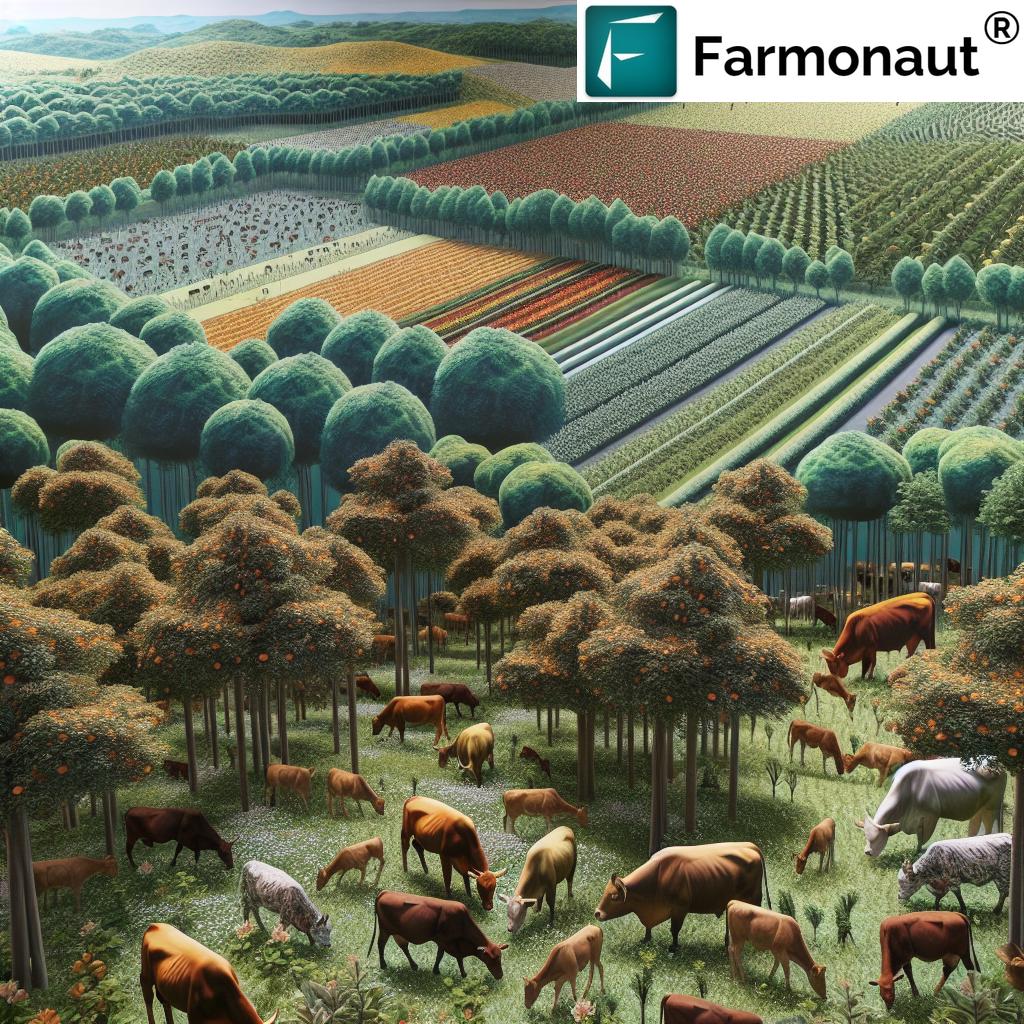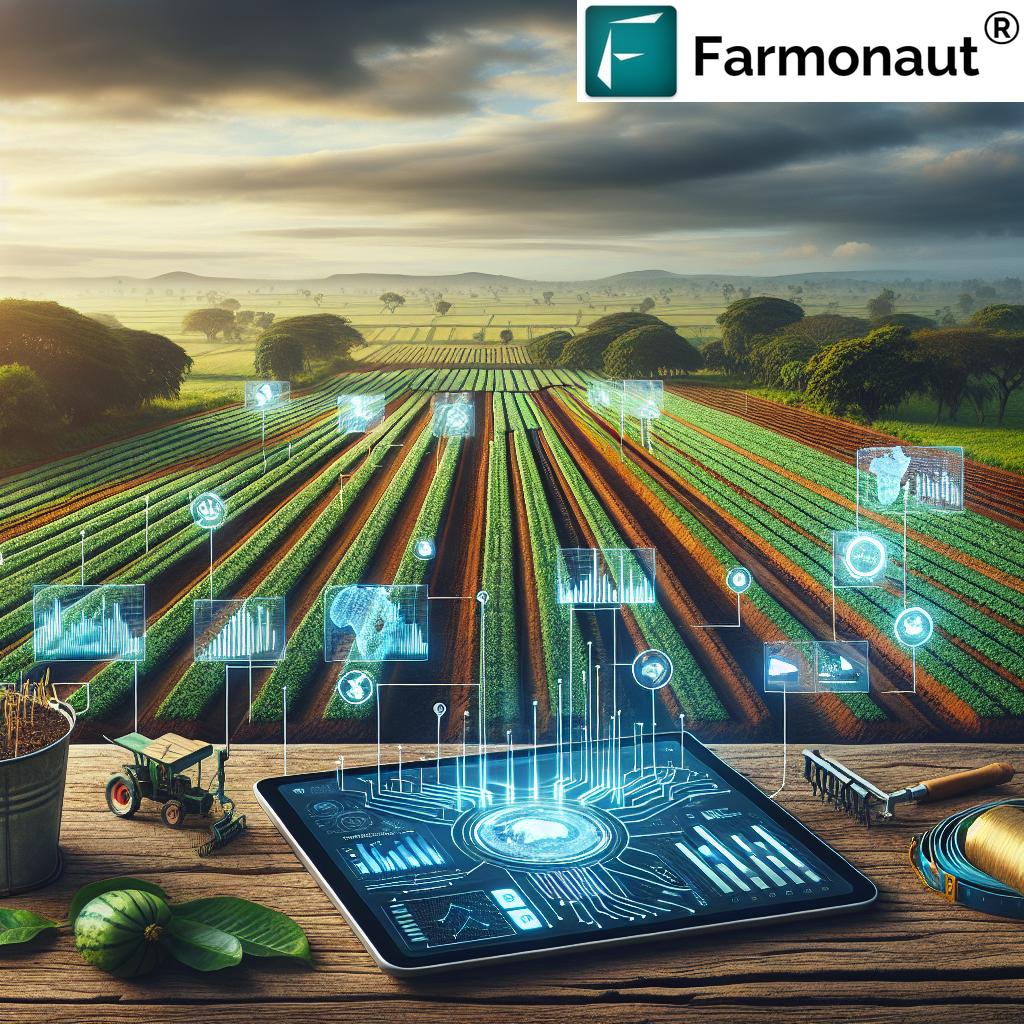Table of Contents
- Profitable Farming and Designing for Farm Success in 2025
- Understanding Profitability in Modern Farming
- Strategy vs. Estimated Impact Table
- 7 Strategies for Profitable Farming and Designing for Farm Success in 2025
- 1. Diversification: Spreading Risk for Reliable Profitability
- 2. Technology Integration: Precision, Efficiency, and Decision Power
- 3. Market Focus: Commanding Premium Prices with Customer Insight
- 4. Sustainable Practices: Building a Resilient, Profitable Farming Business
- 5. Strategic and Financial Management: Maximizing Margins, Minimizing Risks
- 6. Direct & Value-Added Sales: Increasing Margins through Consumer Connections
- 7. Operational Scale & Collaboration: Leveraging Modern Opportunities in 2025
- Market Farming Success: Local Food, CSA, and Niche Markets in 2025
- How Profitable is Farming in 2025?
- How Farmonaut Empowers Profitable Farming and Designing for Farm Success in 2025
- Farmonaut App & Tools: Access, Benefits & Where to Start
- Frequently Asked Questions (FAQ)
- Conclusion: Designing Profitable Farming Operations Beyond 2025
“By 2025, farms using advanced tech and diversification report up to 30% higher profits than traditional operations.”
Profitable Farming: 7 Strategies for Farm Success 2025
Farming has always been the backbone of global economies, feeding populations, sustaining livelihoods, and driving prosperity. But the question remains in 2025: is farming profitable? And if so, how can farmers ensure sustained profitability and competitive farm success in an increasingly complex, data-driven landscape? This comprehensive guide explores profitable farming and designing for farm success in 2025, breaking down 7 proven strategies—from technology adoption to market-savvy planning—that build resilience and boost margins for modern farms. Along the way, we highlight the pivotal role of Farmonaut in making affordable, precision agriculture accessible worldwide.
Understanding Profitability in Modern Farming
Profitability in farming is influenced by numerous factors, including crop selection, input costs, market demand, technology adoption, and environmental conditions. While farming profitability varies widely by region, type of agriculture, and scale of operation, recent advancements in agritech and evolving market trends have created new opportunities for profitability—a trend poised to accelerate in 2025.
Modern farms increasingly operate in highly efficient, data-driven environments. Precision agriculture uses sensors, drones, and AI analytics to optimize planting, irrigation, and pest management, reducing waste and input costs while maximizing yields. These technologies make it easier to maximize output and efficiency, thereby increasing profit margins.
However, profitability is not guaranteed. Fluctuating commodity prices, climate change impacts, and global supply chain disruptions still challenge the business model. Thus, profitability hinges on strategic planning, diversification, and market awareness.
Strategy vs. Estimated Impact Table
| Strategy | Key Technology/Innovation | Estimated Implementation Cost (USD) | Estimated Profit Gain (%) in 2025 | Notes (Potential Market/Operational Benefits) |
|---|---|---|---|---|
| 1. Diversification | Multi-cropping, livestock integration, value-added processing | $5,000–$50,000 | 15–25% | Reduces single-market risk, accesses multiple revenue streams |
| 2. Technology Integration | Precision ag, drones, satellite monitoring, AI analytics | $1,000–$25,000 | 20–30% | Reduces input costs, increases efficiency and yield |
| 3. Market Focus | Niche crops, branding, direct-to-market approaches | $2,500–$20,000 | 10–20% | Commands premium prices, strengthens customer loyalty |
| 4. Sustainable Practices | Soil health, regenerative crops, water conservation, carbon tracking | $500–$10,000 | 10–15% | Improves long-term yields, reduces environmental risks |
| 5. Strategic & Financial Management | Farm management software, flexible budgeting, API integrations | $500–$5,000 | 8–12% | Optimizes cost control, enhances planning & decision-making |
| 6. Direct & Value-Added Sales | CSA, farm shops, e-commerce, processing | $2,000–$30,000 | 15–25% | Higher margins, greater market control |
| 7. Operational Scale & Collaboration | Agro-admin platforms, co-ops, large-scale monitoring tools | $5,000–$100,000+ | 12–18% | Economies of scale, enhanced collective bargaining |
“Strategic planning in agriculture can increase farm profitability by 20% through optimized crop selection and market analysis.”
7 Strategies for Profitable Farming and Designing for Farm Success in 2025
As we step into 2025, profitable farming and designing for farm success demand a holistic, multi-pronged approach. Here are seven strategies modern farmers must embrace to thrive in today’s competitive and volatile agricultural landscape.
1. Diversification: Spreading Risk for Reliable Profitability
Relying on a single crop or livestock stream is risky. Volatile prices, pest outbreaks, or erratic weather can devastate undiversified operations. Diversification means spreading risk across multiple crops, incorporating complementary livestock, or offering value-added products like cheese, honey, or on-farm processed foods.
- Multi-cropping or intercropping boosts overall yields and can improve soil health.
- Mixing livestock and crop production creates natural cycles, reduces waste, and leverages input savings (like using manure for fertilization).
- Adding market products—such as jams, baked goods, or farm-branded meats—captures extra profit and appeals to local consumers.
- Direct farm stands & CSA programs diversify sales and tap into community-supported agriculture demand.
In 2025, many market-oriented farms utilize digital management tools and analytics to identify the most profitable product mix for their region and evolving consumer demand.
2. Technology Integration: Precision, Efficiency, and Decision Power
Adoption of agritech is now essential for profitable farming and designing for farm success in 2025. Farms that leverage satellite imagery, drones, sensors, and AI analytics are better positioned to:
- Optimize planting, irrigation, pest, and nutrient management, reducing input costs and improving yields.
- Minimize waste by detecting disease or water stress early.
- Boost efficiency in farm operations—saving labor, time, and money.
- Access real-time data that informs quick, profitable decisions across hundreds or thousands of hectares.
Solutions like Farmonaut make precision agriculture and farm management accessible—and affordable—even to small and mid-sized operators, democratizing profitability.
Farmonaut’s satellite-based crop health monitoring provides farmers with timely NDVI data, soil moisture levels, and AI-driven advisories, ensuring each field receives optimal resources. This tech integration is critical for increasing margins, reducing input expense, and maximizing yields across competitive markets.
Technology Use Cases for Profitable Farming
- Satellite-based Crop Monitoring: Track crop stress, pest outbreaks, or irrigation demand from anywhere, attain higher yields and profits with less waste.
- Fleet & Resource Management: Tools like Farmonaut Fleet Management help optimize machinery and logistics, reducing fuel, maintenance, and labor costs across complex operations and large geographies.
- AI Advisory Systems: Smart recommendations from real-time data, such as those by Farmonaut’s Jeevn AI, lead to quick response to threats or market trends.
- Blockchain-based Traceability: Traceability solutions build trust with savvy consumers, enable premium pricing, and simplify certification for niche and specialty food markets.
- Carbon Footprint Tracking: Sustainability-conscious operations can leverage carbon accounting tools to measure and improve environmental impact—critical for modern markets and regulations.
3. Market Focus: Commanding Premium Prices with Customer Insight
Understanding and targeting profitable markets is key in 2025. Niche markets—such as organic produce, specialty crops, or traceable local foods—can command premium prices and provide higher margins compared to conventional commodity production.
- Data on local and regional market trends helps farmers choose crops and products that meet evolving consumer demand.
- Branding and transparent supply chains strengthen customer loyalty and justify higher prices—especially for CSA programs and direct sales.
- Combining conventional with specialty products balances volume with margin and spreads risk.
Farmonaut’s Product Traceability tool empowers producers to stand out in premium markets, giving consumers access to blockchain-verified product history.
4. Sustainable Practices: Building a Resilient, Profitable Farming Business
Sustainable and regenerative agriculture practices, once “nice to have,” are now essential. Farms that employ soil health management, efficient water use, and low-impact pest control not only preserve resources—they see higher yields, reduced input costs, and improved marketability.
- Healthier soil translates to better plant nutrition, natural pest resistance, and greater climate resilience.
- Water conservation measures reduce cost and protect crops against drought and regulatory risk.
- Carbon tracking tools (like Farmonaut’s Carbon Footprinting) give farms an edge with eco-minded consumers and buyers.
- Regenerative techniques (cover cropping, agroforestry, composting) build long-term profitability and provide access to carbon markets and sustainability-linked grants.
5. Strategic and Financial Management: Maximizing Margins, Minimizing Risks
Effective financial planning and management underpin every profitable farming business. Smart farms in 2025 will:
- Maintain flexible budgets and monitor expenses in real-time using advanced farm management software and apps.
- Access multiple financing sources, including satellite-based crop loan and insurance verification, to improve cash flow and manage risk.
- Use analytics and forecasting (via platforms like Farmonaut’s API: sat.farmonaut.com/api) for data-driven financial decisions.
- Stay alert to market and policy shifts that impact prices, grants, or compliance.
Profit margins soar when input costs are reduced, waste is minimized, and revenues are diversified—goals directly supported by modern farm management tech and financial tracking solutions.
6. Direct & Value-Added Sales: Increasing Margins through Consumer Connections
Direct marketing—CSA, farm stands, farmers’ markets, or digital storefronts—is thriving in 2025. Farm businesses that sell directly to end customers “cut out” intermediaries and command substantially higher margins.
- CSA and subscription produce programs facilitate upfront cash flow, customer loyalty, and predictable demand.
- Value-added processing (jams, sauces, preserved goods) uses surplus or seconds, increasing returns while reducing food waste.
- Online platforms and e-commerce expand local markets and create nearly year-round revenue for specialty foods.
Pairing direct sales with robust marketing—blockchain-based supply chain transparency, storytelling, and sustainability claims—invite higher prices and attract conscientious consumers.
7. Operational Scale & Collaboration: Leveraging Modern Opportunities in 2025
Profitability often comes with the right balance of scale and collaboration. In 2025:
- Large-scale operators deploy digital fleet/resource management, satellite field monitoring, and multi-farm planning software. (See Agro Admin App for efficiently managing large and distributed operations.)
- Small and mid-sized farms join co-ops or collaborative platforms to improve purchase power, pool resources, and access higher-value contracts.
- Collaborative farm management platforms support everything from fleet scheduling to large-scale, compliance-ready recordkeeping.
Efficient scale—whether by size, region, or partnerships—reduces unit costs, increases competitiveness, and enables profitable participation in lucrative supply chains.
Market Farming Success: Local Food, CSA, and Niche Markets in 2025
Market farming success in 2025 is built on understanding customer needs, maintaining product quality, and efficiently managing logistics. As consumer demand for fresh, traceable, and sustainably produced food rises, market-focused farms can achieve:
- Higher prices per unit sold, premium for “local” or specialty/gourmet items;
- Loyal, returning customer bases who value transparency and freshness;
- Reduced competition from global commodity chains.
However, market farming can be labor-intensive—success depends on excellent business design, data-driven management, and technology use. Farms must balance production with direct sales, customer service, and marketing for best results.
Farmonaut helps by providing crop health monitoring, resource tracking, and real-time field insights, ensuring that even small-scale operations can achieve efficiency and profitability.
How Profitable is Farming in 2025?
The profitability of farming in 2025 varies dramatically by region, crop selection, management quality, and technology adoption:
- Commodity crop farms still face price volatility, with profit margins often between 5% and 10%.
- Farms embracing technology, diversification, and specialty markets routinely see margins of 10% to 25%, and in some cases, even higher when combining regenerative agriculture with direct marketing.
- Strategic planning, supply chain optimization, and cost control can raise profitability by 20% or more on modern farms.
Key profitability factors for 2025:
- Data and analytics-driven management;
- Efficient, precision resource use (via sensors, satellites, and AI);
- Product and market diversification;
- Direct-to-consumer sales models;
- Financial prudence and rapid adaptation to market changes.
In short, profitable farming and designing for farm success in 2025 isn’t just about higher yields—it’s about better decisions, timely data, and system-level integration of agro-business, technology, and market strategies.
How Farmonaut Empowers Profitable Farming and Designing for Farm Success in 2025
At Farmonaut, our mission is to make precision agriculture accessible and affordable for farmers worldwide. We bridge the gap between modern technology and the daily realities of farming, offering a comprehensive platform that supports profitable farming business design, management, and sustainability from the ground up.
- Satellite-Based Crop Health Monitoring: We leverage advanced satellite imagery to provide farmers with real-time data on vegetation health, soil moisture, and nutrient status. This empowers smarter resource allocation, reduces input waste, and maximizes yield.
- Jeevn AI Advisory System: Our AI-driven tool delivers personalized farm insights, weather forecasts, and on-demand management recommendations for improved productivity and efficiency.
- Blockchain-Based Traceability: With secure, end-to-end supply chain visibility, farms can provide trusted origin stories for buyers and consumers. Explore product traceability features to learn more.
- Fleet and Resource Management: For farms and agribusinesses, we provide logistic tools that optimize vehicle use, schedule maintenance, and track operational costs. See how fleet tools streamline costs.
- Carbon Footprint Tracking: We enable modern farms to monitor and reduce their environmental impact, supporting both compliance and premium eco-markets.
Our platform is built for individual farmers, cooperatives, agribusinesses, and government clients of all sizes. With flexible subscription models and open platform access, every client—from smallholder farm to national-scale operator—can design for profitable farming and market success.
Farmonaut App & Tools: Access, Benefits & Where to Start
Farmonaut is available globally via Android, iOS, web/browser App, and API. Getting started is simple—just select the platform that fits your workflow:
-

Web App: For complete farm management, field monitoring, and advisory integration. -

Android App: Portable, real-time access to crop and resource management on the go. -

iOS App: Powerful precision agriculture access for iPhone and iPad. - API Access (API Developer Docs): Integrate our satellite and farm management data into your own software or platform.
All users also benefit from crop loan & insurance verification (for easier finance), large-scale management tools, and forest & plantation advisory.
Ready to make precision agriculture work for your farm in 2025?
Explore subscriptions and pricing:
Frequently Asked Questions (FAQ)
What is profitable farming and designing for farm success in 2025?
Profitable farming and designing for farm success in 2025 refers to integrating technology, sustainable practices, market intelligence, and strategic planning into farm operations to increase efficiency, reduce risks, and maximize profitability in a changing, competitive landscape.
Is farming profitable in 2025?
Yes—farming can be highly profitable in 2025 for those who adopt innovation, diversify crop and income streams, embrace market niches, and manage resources effectively.
What role does technology play in profitable farming?
Technology (like satellites, AI, drones, and management software) improves decision power, resource use, and yield, while reducing expense and environmental impact—directly boosting margins.
How does Farmonaut help with profitable farming business?
Farmonaut provides precision agriculture tools, satellite-based monitoring, AI advisories, resource/fleet management, and traceability—making affordable, data-driven management accessible to all farm sizes.
Which crops or markets are most profitable in 2025?
Profitability varies by location, demand, and management, but niche, specialty, organic, and locally branded crops/products often command higher prices and returns than commodity markets.
Can small farms achieve market farming success?
Absolutely. Direct-to-customer models, CSA, and specialty product focus enable even small farms to thrive with superior margins if they deploy technology smartly and understand local demand.
How do I start using Farmonaut?
Choose your preferred platform—web, Android, iOS or API—and select the tools that match your needs. No large investments or complex hardware are required—Farmonaut leverages satellite and cloud infrastructure for cost-effectiveness.
Conclusion: Designing Profitable Farming Operations Beyond 2025
Profitable farming and designing for farm success in 2025—and beyond—mean evolving beyond tradition. The most successful farms fuse visionary planning, technological innovation, and market-driven practices to meet the challenges of modern agriculture. By investing in diversification, tech adoption, efficient management, sustainability, and customer-centered sales, today’s farmers can build businesses that are resilient, competitive, and highly profitable—regardless of scale, region, or crop.
At Farmonaut, we’re committed to helping the global farming community thrive in a rapidly changing landscape. Our affordable, scalable suite of apps, platforms, and data-driven solutions empowers farmers in every region to:
- Make informed, profitable decisions using cutting-edge analytics;
- Reduce risk and expense by embracing sustainable, proactive management;
- Tap new markets—and improve margins—through traceability and direct sales;
- Benefit from expert advisories, real-time monitoring, and flexible digital infrastructure.
Now is the time to re-design your farm for success.
Join the next wave of profitable farming—explore precision tech, invest in knowledge, and let data guide your growth in 2025 and beyond.








